IN THE PUBLIC INTEREST
INSIDE: CEC IS WORKING HAND IN HAND WITH PUBLIC SECTOR CLIENTS ACROSS THE COUNTRY
2023 Vol. 1

FRAMING THE SKYLINE
Photo Credit: Ellie Wind, Survey Technician I, Fishers Office
The photo was taken in Indianapolis, Indiana, where Ellie was completing survey work for new construction in the Bottleworks District.

CEC sponsors a photo-of-the-month contest encouraging employees to submit photos from their work sites. Winning photos are published on CEC’s internal website and social media pages. One is selected for Elements.
Elements is published by Civil & Environmental Consultants, Inc. for clients, business partners, and other associates.
JONNA MILLER // Content & Creative
EMILY KINS // Digital
JARED MURPHY // Digital
EMILY CHIODO // Editor
Civil & Environmental Consultants, Inc.
700 Cherrington Parkway Moon Township, PA 15108
www.cecinc.com
For information, address changes, corrections, or additions to the mail or email list, contact 800.365.2324 or email elements@cecinc.com
ON THE COVER: As part of its contract with the Tennessee Department of Transportation, CEC performs monthly site inspections for quality assurance on active TDOT roadway projects.
WELCOME
This issue highlights our service to our public sector clients. We are very proud of our work with our long-term public sector clients and have made solid investments in people and initiatives that will allow us to continue to serve those clients and demonstrate the expertise and professionalism that will support our growth in this market.
One of our great, long-term success stories has been our ongoing relationship with the Tennessee Department of Transportation (TDOT). Since the early 2000s, we have partnered with TDOT to help them successfully deliver their infrastructure projects. The relationship between TDOT and our Nashville office has grown stronger with our ability to incorporate more service offerings across multiple CEC disciplines.
While we’re on the topic of transportation, our Public Sector transportation services have been significantly expanded under the leadership of Anthony Yacobucci, who is featured in our Spotlight: Q&A section of this issue. Tony’s extensive transportation services background has helped our firm build teams in several of our office locations and tailor our service offerings to meet the needs of the market. You’ll enjoy learning more about what attracted Tony to CEC and some of the changes he has seen in transportation during his impressive career.
CEC has, since our founding, put its focus on people. This has been a guiding principle in the decisions we make every day. So it stands to reason that we understand how critical projects within the Public Sector are. We strive to work as partners with public officials and agencies facing funding challenges, aging infrastructure, and regulatory
uncertainties to help them provide comprehensive and reliable solutions that address the challenges in their communities. In the pages that follow, we highlight the diverse expertise, service offerings, and geographies that enable us to provide comprehensive project execution for Public Sector clients throughout the U.S.
Sincerely,
4
CONTENTS
TDOT'S TRUSTED PARTNER Answering the call in all areas of public sector work in Tennessee.
7
PLYMOUTH ROCKS
CEC has a hand in the restoration and renewal of America’s Hometown.
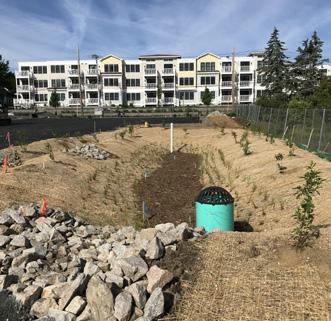
12
SPOTLIGHT: ANTHONY YACOBUCCI
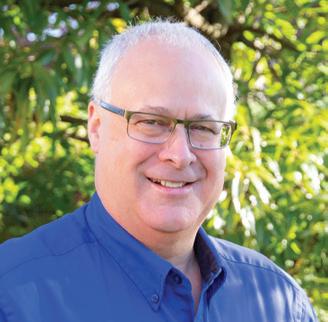
CEC's Public Sector Transportation Lead reflects on the past, family, and his future with the firm.
15
IN CASE YOU MISSED IT ... BLOGS
A collection of posts to update you on pertinent topics from the regulatory world.
 Dustin Kuhlman, President & CEO
Dustin Kuhlman, President & CEO
15
EVERY DROP COUNTS
10 Designing projects to get water to those who need it most.

AMERICAN RESCUE PLAN ACT UPDATE

Guiding communities in the utilization of the federal American Rescue Plan Act funding.

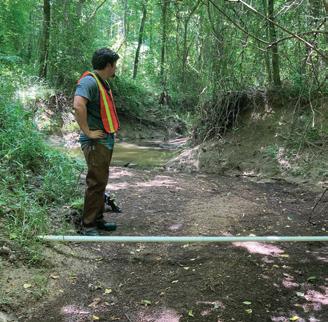
3 ELEMENTS
TDOT'S TRUSTED PARTNER
CEC ANSWERS THE CALL IN ALL AREAS OF PUBLIC SECTOR WORK
The transportation business is booming in Tennessee and CEC is right smack in the middle of it on a variety of fronts in its work for the Tennessee Department of Transportation (TDOT). CEC offers a clear understanding of regulatory responsibilities and an integrated approach to engineering, design, construction, and consulting, We work with TDOT to provide comprehensive, reliable, and cost-effective solutions that address the challenges of the state’s unique infrastructure and economic development projects. From the unprecedented Blue Oval City to Stormwater Pollution Prevention Plans to stream mitigation, CEC’s experts have been busy meeting TDOT needs. •
BLUE OVAL CITY
Blue Oval City is a planned $5.6 billion automotive assembly complex near Stanton, Tennessee, which will be
operated by Ford Motor Co. and SK Innovation. The facility, named for the Ford logo, will consist of an assembly plant that will produce electric Ford F-150 Lightning pickup trucks. Trucks are expected to roll off the assembly line in 2025.
The massive 4,100-acre site will also be home to a plant that will manufacture electric vehicle batteries, as well as a battery recycling facility.
“It is the biggest thing going on in this state,” says Matthew Skelton, a Project Manager in CEC Nashville’s Ecological Sciences practice.
Given the network of roadways needed to accommodate this immense plant, TDOT called on CEC to handle initial environmental studies, permitting and mitigation needs, and road and interchange design on the previously undeveloped lands.
“It’s a very rural area but its proximity to Memphis allows quick access. It’s the only place in Tennessee with this many contiguous acres with access to numerous modes of transportation and a nearby Foreign Trade Zone,” Skelton said.
“We evaluated 1,500 acres for stream/wetland delineations. We had people walking the entire site during the data collection,” says Tim Nehus, Ecological Sciences Practice Lead in the Nashville office. “We were on a very tight timeline, as the
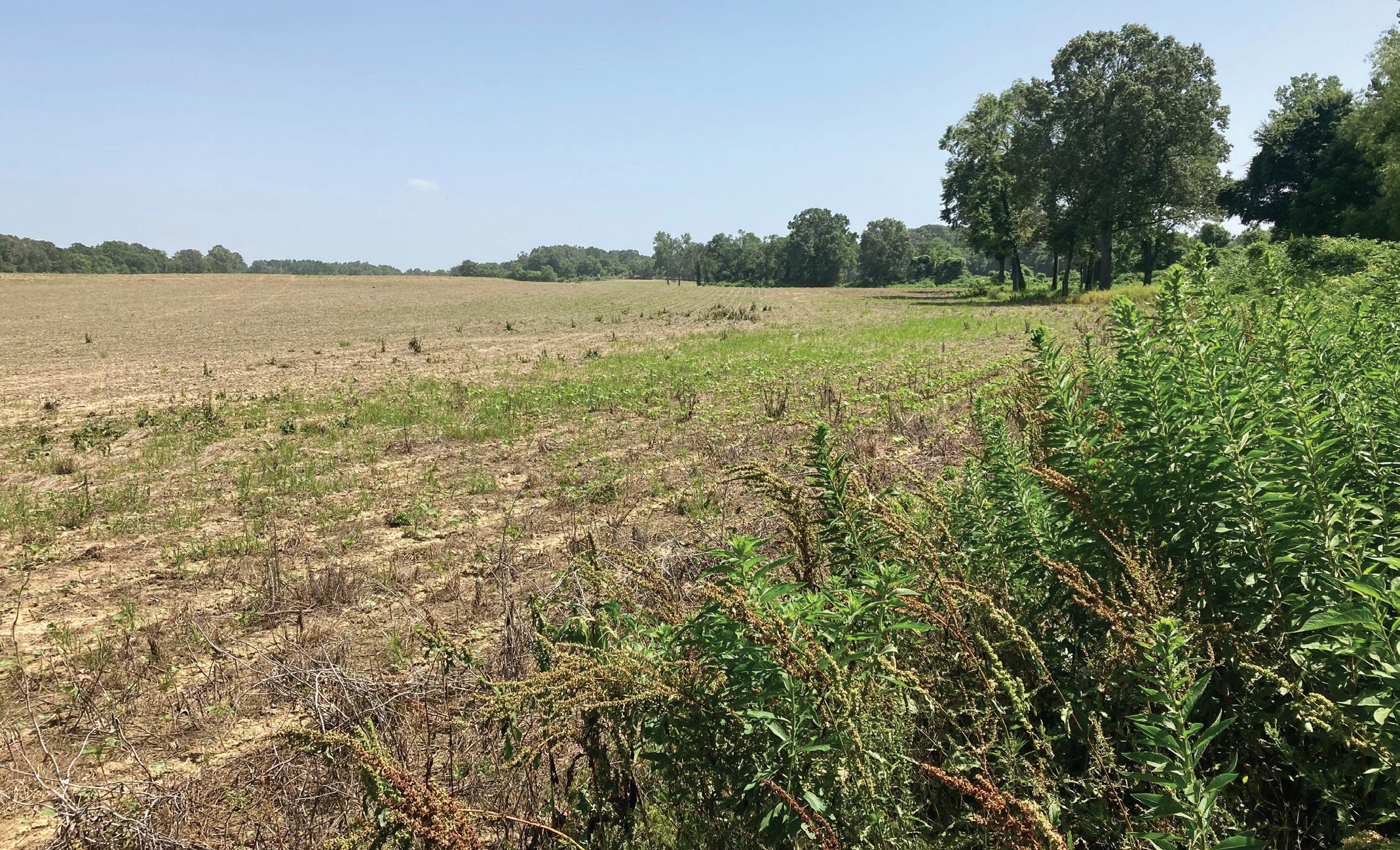
4 ELEMENTS
•
•
HAND IN
FUTURE
A
THE
The Tennessee Department of Transportation called on CEC to handle a number of engineering services at Blue Oval City.
WHAT WE DO
CEC’s Public Sector Transportation Services include:
■ Highway and Roadway Design
■ Bridge Inspection and Design
■ Bicycle and Pedestrian Facility Design
■ Corridor Studies
■ Traffic Engineering
■ Traffic Signal Design
■ Maintenance of Traffic
■ Hydrology/Hydraulic Analysis
■ Surveying (Conventional, LiDAR, UAS)
■ Subsurface Utility Engineering
■ Right-of-Way Plans
■ Erosion and Sediment Control Plans
■ Geotechnical Engineering
■ Pavement Design
■ Environmental Services
■ Public Involvement and Outreach
■ Construction Engineering
■ Construction Management
technical studies were in a constant state of adjustment.”
Road work around the site has been underway since October 2021, with 16 miles of roads needed to service the plant. A new interchange is on tap at Interstate 40, while another nearby interchange will be upgraded to handle the increased traffic in the area.
“Our strong relationship with TDOT is the reason we were awarded this project. There are a lot of infrastructure improvements and development associated with the construction and operation of Blue Oval, and CEC is positioned to take this work on as it develops. We will gather more work because of it,” Nehus added.
SWPPP DEVELOPMENT
CEC also lends its extensive expertise in Stormwater Pollution Prevention Plans (SWPPP) to TDOT. “We can be assigned to projects anywhere across the state, concentrating mostly in central Tennessee,” says Janette L. Wolf, P.E., a Principal in the Nashville office.
She leads CEC’s On-Call Construction Quality Assurance and Corrective Action Contract and the Permits Contract for TDOT Region 3.
TDOT contracts with CEC for monthly QA inspections of its roadway projects.
In this capacity, CEC is responsible for:
■ authoring photo journals and assessment reports
■ documenting erosion and sediment control measures in place throughout construction
■ providing comments to facilitate the project’s implementation of erosion control measures
■ compliance with applicable water quality permits.
The contract management also includes administration, estimate preparation, invoicing, and staff coordination.
CEC’s involvement with TDOT’s complex SWPPP projects is cradle to grave.
“The sheer number of people CEC has involved is just phenomenal. We are working toward one collaborative goal,” Wolf says.
ELEMENTS
CEC has had contracts with TDOT since 2004 and will again re-apply in 2024 for the next three-year contract period.
As the SWPPP consultant, CEC is ensuring established standards are met at every phase of the project — the roadway design guides, the TDOT drainage manual guidelines, and the TDOT standards.
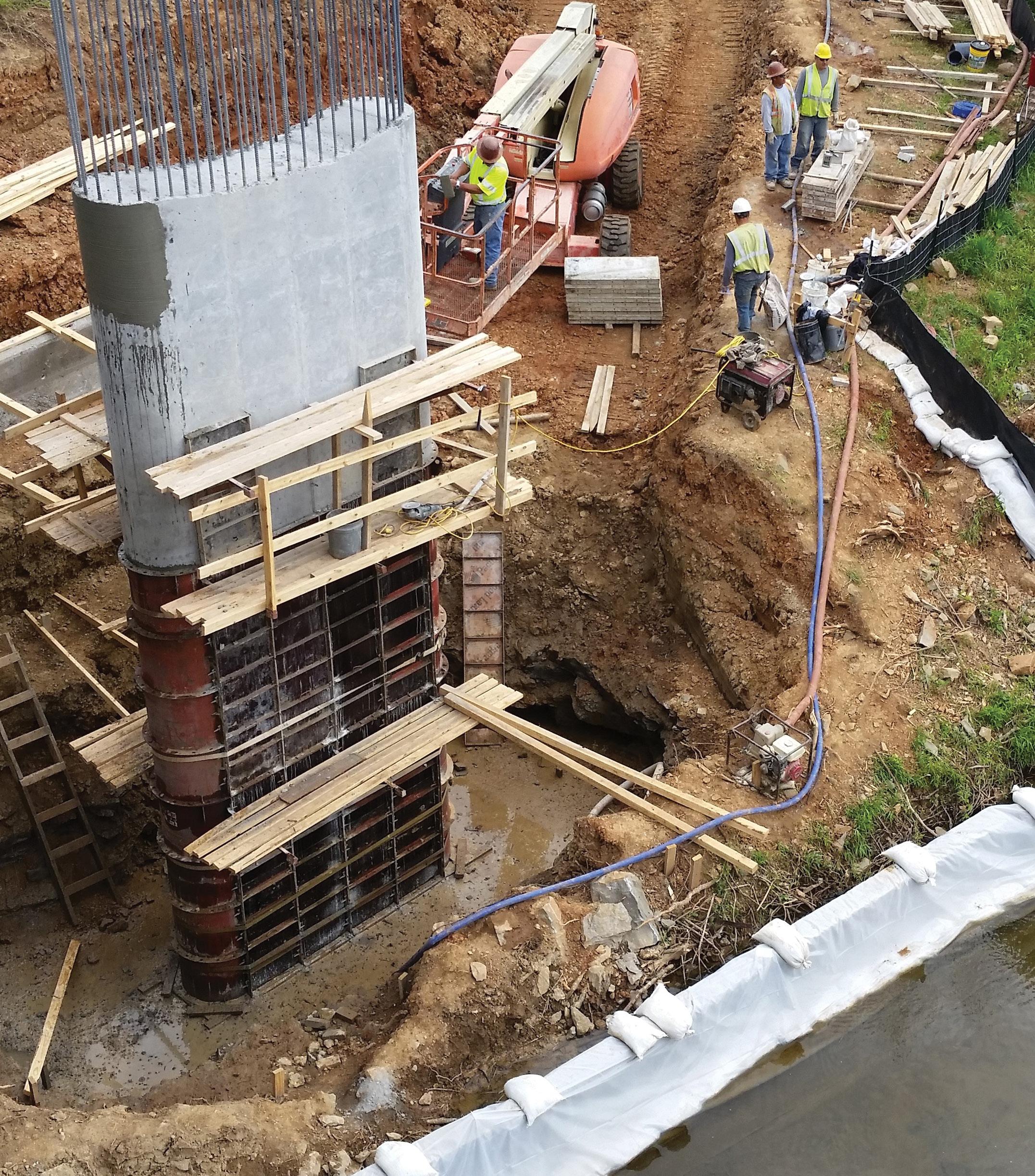
“The bulk of what we do is commenting on compliance to TDOT standards,” Wolf says.
CEC is directly coordinating with the designer and commenting collectively on the various phases of the project as it moves along toward completion.
“I enjoy the diversity of people — consultants, designers, engineers — I get to work with. I like to see how to apply the standards in a practical manner,” she adds.
5
CEC performs quality assurance site inspections for TDOT roadway projects.
STREAM MITIGATION
With more than 20 years of civil engineering, water resources, and project management experience in both the public and private sectors, CEC Nashville Principal Jeffrey B. Shaver, P.E., CFM, is a guiding force for a number of TDOT stream mitigation projects.
CEC truly offers start to finish, A to Z services in stream mitigation.
“Nashville has performed some level of stream mitigation work with TDOT since the early 2000s,” Shaver says.

“Through our On-Call Contract, TDOT sends us a work order for natural channel design for streams that will be impacted during a proposed road project. The projects may be for streams being relocated within the roadway right-ofway or for restoring another degraded stream to offset the impacts from the roadway project. We then evaluate the existing streams to determine the best restoration approach to return their natural/historic functions,” Shaver says.
The process starts in the field. “We evaluate the existing stream and score it using the Tennessee Stream Quantification Tool (TN SQT). The primary purpose of the TN SQT is to calculate functional lift and loss associated with stream restoration and impact projects,” he adds.
CEC then uses the TN SQT throughout design to estimate the score of the relocated or restored stream to show the functional lift. “Our Ecological,
Survey, and Water Resources practices work together to make the restoration plan,” he says.
“A typical stream restoration plan includes incorporating meanders, pools, and riffles into the stream. Wood and stone structures along with a vegetation plan for the stream buffers are also part of the plan to provide habitat. As part of TN SQT, we look at the aquatic organisms at the beginning and then regularly during the five- to seven-year monitoring of the restored stream.”
“When we do the design work, then managing the project and overseeing the stream construction is more seamless for our client,” he says.
A TRUE PARTNER
Building trust, familiarity, and confidence is paramount in CEC’s relationships with its clients. When public officials and agencies are facing funding challenges, aging infrastructure, and regulatory uncertainties, we offer a clear understanding of regulatory responsibilities and an integrated approach to engineering, design, construction, and consulting.
CEC works hand in hand to provide comprehensive, turn-key services and reliable, cost-effective solutions that address the challenges of a community’s unique infrastructure and economic development projects. ■

6 ELEMENTS
I enjoy the diversity of people — consultants, designers, engineers — I get to work with. I like to see how to apply the standards in a practical manner. ”
JANETTE L. WOLF, P.E. Principal Nashville Office
CEC Nashville has been performing stream mitigation work for TDOT since the early 2000s.
PLYMOUTH ROCKS
RESTORATION, RESILIENCY, AND RENEWAL IN AMERICA’S HOMETOWN
Brownfield projects are in CEC’s DNA, harkening to the firm’s roots in Pittsburgh, Pennsylvania.
Tim Murphy, CEC’s Corporate Public Sector Market Group Lead, says CEC has a 30 plus-year history with large sites in the City of Pittsburgh and along its rivers. That expertise has now extended far and wide to reclamation of contaminated sites all across the country.
Brownfield projects don’t just include old manufacturing sites and steel mills. In fact, CEC has been integral in a series of impressive restoration and renewal projects that have taken place in one of America’s oldest towns — Plymouth, Massachusetts, with Jon Kitchen, Environmental Principal in CEC’s Boston office, at the helm.
Modernizing centuries-old sites and structures presented a unique blending of restoration with renovation and reimagining in the quaint and iconic New England town of Plymouth.
PLYMOUTH TOWN HALL
Plymouth is the site of the colony founded in 1620 by the Pilgrims.
It is about 40 miles south of Boston in a region
known as the South Shore. It’s a mecca for tourists and history buffs, alike.

In 1820, a courthouse was built in celebration of Plymouth’s 200th anniversary. The structure sat in the heart of downtown and after almost 200 years of additions and patchwork repairs, the courts moved out of the building in 2008 and a new vision was required for this historic building. The Town of Plymouth purchased the building in 2009
BROWNFIELD
noun: a former industrial or commercial site where future use is affected by real or perceived environmental contamination.
Use this QR code to watch our expert Mike Coonfare of CEC Toledo discuss brownfield work in Ohio.

ELEMENTS 7
•
• •
and leased the property to the Plymouth Redevelopment Authority (PRA) for redevelopment.
In preparation for the 400th anniversary celebration in 2020, the building was renovated to become the gateway to a new town hall complex.
In early 2015, CEC was engaged to assess site conditions prior to issuing a request for bids for the demolition of several buildings within the footprint of the new complex and the partial demolition of newer portions of the courthouse. With demolition scheduled for the winter of 2015, CEC was tasked with completing an assessment of a two-and a-half-block area with several current and former buildings in a matter of weeks.
CEC, understanding the historical significance of the building, worked carefully with the town officials to plan the execution of certain testing such as destructive building materials testing.
“The brick shell of the old courthouse was re-imagined as office suites, with a beautiful glass lobby leading from the old to the new building,” says David Gould, Plymouth’s Director of the Department of Marine and Environmental Affairs (DMEA).
While the town hall project combines old-school charm and modern amenities, it was not without its challenges, Gould adds.

A simple parking lot renovation for the new facility proved especially troublesome.
A pair of former schools on the property had been demolished years earlier, with all of the debris swept into the foundation and paved over for a parking lot. The lot had developed sinkholes over the years due to the shifting, buried asbestos-laden building materials.
To address these issues, CEC promptly determined the approximate volume of waste and prepared bid documents relating to the waste. CEC also located and uncovered an underground storage tank (UST) that had been reported but was unable to be located by prior consultants.
During the course of the project, CEC provided a number of services including due diligence/facility assessment, environmental site investigations, geotechnical investigations, predemolition building surveys, asbestos sampling and consulting, and hazardous materials inventories.
FORMER REVERE COPPER PLANT REMEDIATION
This Plymouth project involved the capping of zinc-contaminated soil beneath a parking lot between Plymouth Harbor and Water Street.
It was the site of the former Revere Copper plant, dating back nearly 100 years. With CEC’s assistance, the town garnered three EPA brownfield cleanup grants for the work on three lots on Water Street. The lots were part of a former wetland that was presumably filled with contaminated materials containing zinc. Ongoing storm damage to the site was creating the potential eco-hazard risk of this material entering the harbor and bay.
“Trucking it all out was not feasible. We worked with CEC to cap the site, similar to a landfill,” Gould says.
By capping it, rebuilding the coastal revetment, and removing the traditional stormwater system in favor of a bioretention facility, DMEA was able to stabilize the site and protect the marine environment.
“It doesn’t get a lot of notoriety, but to me this was the single-most important project in the redevelopment of the harbor,” he says.
TOWN BROOK
Town Brook is a 1.5-mile stream in Plymouth that supplied drinking water
to the Pilgrims who made their homes adjacent to the brook.
Town Brook plays host to an annual migration of river herring each spring. Two species of herring are an anadromous species, meaning they migrate from the Atlantic Ocean up these freshwater rivers to spawn every year.
The herring were an important food source for both the Native Americans and the Pilgrims, who settled in the area. In addition to feeding the masses, the herring also provided fertilization to the corn crops. The Native Americans shared that fact with the Pilgrims.
A series of six dams, dating back to 1638, along the waterway had a serious impact on these fish making their way to their spawning grounds. A recently completed series of projects left the stream free and clear with just one dam for the fish to navigate through now.
“Jon (Kitchen) has been amazingly integral to this project,” Gould says. His knowledge as a Massachusetts Licensed Site Professional (LSP) was a key element in the successful outcome of this design.
This complex project removed not only the dam structures, but also a former mill and the sediment that had accumulated in the various impoundments over decades and decades.
“As an LSP, Jon guided us through all of the state regulations and disposal options. He had the information about
8
ELEMENTS
The Plymouth Town Hall combines old-school charm with modern amenities.
the cost of disposal of the sediment, the dam removals, and the sediment sampling process, and he employed his knowledge of local landfills and tipping rates,” Gould says.
CEC was involved in the management of contaminated sediments from the impoundments downgradient of the mill.
CEC and its project partners were the reciepients of an “outstanding collaboration” award by the Environmental Business Council of New England for that phase of the project. The removal of the mill was funded, in part, by brownfields grants from MassDevelopment, the Commonwealth’s development finance agency and land bank, which works with businesses, nonprofits, banks, and communities to stimulate economic growth. Other properties along the river with an industrial past were also addressed as part of this initiative.
This project is especially close to Gould’s heart, whose family dates back to the Mayflower and Plymouth’s Pilgrim settlers.
“The river health is what I’m most passionate about.”
The restoration of a new channel with improved habitat and water quality has helped residents, fish, and wildlife.

The herring run is a spring rite of passage, which attracts thousands of visitors to Plymouth.
DAVID GOULD Plymouth’s Director of the Department of Marine and Environmental Affairs
START TO FINISH
The goal of a brownfield redeveloment is to put a property back into productive use—a goal and a process in which CEC takes pride by offering our expertise, experience, and a personal touch.
The success of these projects in Plymouth shows the depth and breadth of the services offered by CEC. “These revitalization projects illustrate how CEC can stretch that goal with coastal resiliency, ecological protection, ecosystem restoration, and public infrastructure benefits,” Kitchen says.
In fact, the town holds an annual Herring Festival, a life re-affirming event after a long Massachusetts winter. “It’s on April 23, the day after Earth Day,” he says.
Another species benefiting from CEC’s expertise in dam removal are the eels heading back out from the fresh water to spawn in the Sargasso Sea. “Kids are fascinated by the eels. It’s very cool to see,” Gould says.
“We are grateful we get to choose to work with people who we have faith in and put our trust in … Jon (Kitchen) is a rock star.”
As a full-service, multi-disciplined firm, CEC brings a comprehensive approach to brownfield redevelopment where our engineers and environmental specialists work together to provide synergistic solutions that optimize reuse of a property through the site design process and the use of practical engineering and institutional controls.
While we are certainly capable of approaching brownfields from a traditional perspective, CEC likes to approach every project from a fresh perspective. This is why CEC was the right consultant to work on these sites. “We take an economic development opportunity with environmental challenges, assess it, clean it up, and repurpose it. CEC can do all aspects of the project — start to finish,” Murphy adds. ■
9
ELEMENTS
During the renovation of Town Brook, the Plymco Dam was removed, improving habitat and water quality.
We are grateful we get to choose to work with people who we have faith in and put our trust in ... Jon (Kitchen) is a rock star.”
EVERY DROP COUNTS
CEC PROJECTS GET PUBLIC WATER TO THOSE WHO NEED IT
Turning on the faucet and filling a glass with clean, fresh water seems like a normal part of any day. That, however, is not always the case.

“You’d be surprised by the number of people without public water. There are a lot of wells still in this country,” says Matthew Fluharty, Water Resources engineer, and a Vice President in CEC’s Bridgeport office.
“Nobody really thinks about water until you turn on the tap and there is none. We can’t live without water.”
Fluharty, early in his 22-year career, rolled up his sleeves and learned all he could about water projects. Since joining CEC in 2018, he’s thankful for the opportunity to help bring water to those who need it all across the country and in the U.S. Virgin Islands.
There are many people who either have poor quality well water or a lack of volume — or both.
CEC provides comprehensive services to design and support construction of expansions and extensions to public water systems to get clean water to people in need.
“When it comes to water line extensions, there is a definite need,” Fluharty says. By the time a project gets to us, it’s something people want. “We are working with
cities, towns, townships, and water authorities as we design these extensions. We are helping to provide a clean, reliable source of potable water.”
TACKLING CHALLENGES, EXCEEDING EXPECTATIONS
Each and every water project undertaken by CEC comes with its own set of challenges. CEC tackles those challenges with confidence. “Every public sector water project is unique; CEC always relies on the fundamentals and the requirements of how the system needs to work,” Fluharty says.
For the most part, these line extensions are multi-phase projects. CEC designs the plan to extend a line a few miles and when the need arises again, goes back and designs
10 ELEMENTS
another extension of the same line for a few more miles. “It’s all based on need,” Fluharty says.
He points to a $2 million project in Pennsboro, West Virginia, as an example. The first phase added 30 new customers, while the second added another 20 to 30. “When it comes to water, the lines can keep being extended. It’s good for everyone — the water entity and the customers.”

Another big CEC project resulted in 400 customers having access to public water for the first time. “By the time we were awarded the project, those customers were anxiously awaiting its completion,” Fluharty says.
THE PROCESS
CEC provides municipalities with full-service capabilities including studies, analysis, and engineering. CEC also provides:
■ Support for financing and funding
■ Surveying
■ Design drawings and specifications
■ Bidding and construction-related services
CEC hydraulically analyzes existing and proposed transmission mains, as well as local lines of a community’s water distribution system.
The analyses identify lines and areas requiring upgrading or reinforcing to meet local needs, Fire Underwriters Survey recommendations, and EPA requirements. Thorough hydraulic analyses of distribution systems and storage tanks sometimes identify the need for additional or replacement water storage tanks.
CEC designs elevated water storage tanks and standpipes to provide water ready for delivery without pumping. Elevated storage tanks stabilize system pressures, provide water for firefighting, and allow plants to treat water at a more constant rate where their operation works best and is most efficient.
CEC also designs ground storage tanks with pumping facilities as an alternative to elevated storage tanks. CEC designs and prepares final drawings and specifications for various water storage tanks and assists clients with the bidding and construction phases of each project.
Pump stations are used to boost area
pressures — the water pressure provided to customers. “We often need to build a pump station to boost water pressure to areas that have low or no pressure,” Fluharty says. This commonly occurs in larger systems or when surface topography reduces area pressures significantly.

CEC analyzes the community’s specific needs and designs in-line booster pumps or pump stations with associated ground or elevated storage to increase area pressures.
BUILDING ON EXPERIENCE
“We continuously learn by working with project managers and contractors. Our expertise builds with each project,” Fluharty says. CEC calls upon the collective experience of its water experts in 29 offices across our footprint for all projects — both public and private. We bring collective best management practices and senior leadership insights into everything we do. ■
ELEMENTS
11
Pump stations are designed within the system to boost water pressure.
Every public sector water project is unique. CEC always relies on the fundamentals and the requirements of how the system needs to work.”
MATTHEW FLUHARTY Vice President Bridgeport Office
ANTHONY YACOBUCCI
PUBLIC SECTOR TRANSPORTATION LEAD
When Anthony Yacobucci joined CEC Cleveland early in 2022, he brought with him 34 years of experience and expertise in managing transportation projects from conceptual planning through construction.

His strong technical background in structural engineering includes experience with specialized structures, such as concrete and steel arch structures, various types of movable bridges, through and deck truss structures, curved girders, and complex framing layouts. He has also garnered experience in parking structures, building complexes, toll roads, and coastal facilities.
Yacobucci is a Professional Engineer in Ohio, Pennsylvania, and West Virginia and is a member of the American Society of Highway Engineers, the Association for Bridge Construction and Design, and the American Council of Engineering Companies of Ohio.
Before joining CEC, Yacobucci served as the chief engineer of the Ohio Turnpike and Infrastructure Commission (OTIC).
In this capacity, he was responsible for the daily operation, maintenance, preservation, expansion, and capital improvements of the Ohio Turnpike, which is comprised of 1,395 lane miles of roadway, more than 1,000 bridges and culverts, 14 service plazas, eight
maintenance buildings, two administration buildings, and 31 toll plazas.
He also oversaw OTIC’s Over-Dimensional and Overweight Vehicle Permit System, Long-Combination Vehicle Permit System, overhead and underground utility crossing permits, Stormwater Management Program, as well as the development and maintenance of standard drawings and specifications. Yacobucci also assisted in negotiating, managing, and administering the Collective Bargaining Agreement for the maintenance personnel.
In addition to serving as chief engineer, Yacobucci served as the Program Director for OTIC’s Toll Collection System Modernization Project. The $450 million program included the complete replacement of the Toll Collection System, a revitalized Customer Service Center, and a new Unpaid Toll Processing System.
That knowledge is utilized every day as he serves in the Civil Engineering practice of the Cleveland office and as the firm’s Public Sector Transportation Lead. Yacobucci coordinates CEC’s efforts to enhance and expand the firm’s services to the public sector transportation market.
Here, he shares his journey to CEC and his progress since his arrival, reminisces about the “old days,” and looks ahead to what might be on the horizon for the future of transportation.
QUESTION: AFTER HAVING SPENT MORE THAN A DECADE AS THE CHIEF ENGINEER OF OTIC, WHAT SPURRED YOUR DECISION TO JOIN CEC?
ANSWER: “I actually did consulting work for 22 years prior to my turnpike work. The early mornings and late nights while trying to maintain a quality family life took its toll. My wife and I had a kindergartner and a sixth grader. I was coaching baseball and basketball. It just wasn’t how I wanted my family life to be. The turnpike job was appealing with its consistent schedule, affording a more normal home life. My whole goal was
to be there for my family and be able to raise our children. I knew I wasn’t going to retire from the turnpike. Fast-forward to late last year, our son was in medical school and our daughter committed to Division I Wright State University on a volleyball scholarship. I thought it would be a good time to get back into consulting and pursuing my
passion to work with a variety of clients again.
I had heard about CEC’s reputation as a peoplefirst company. It’s an organization clearly making changes for the betterment of its employees. I met with Dan Szwed (Chief Operating Officer), John DiNunzio (Vice President of Operations), Dustin Kuhlman (CEO), and Ken Miller (Chairman) and knew
12 ELEMENTS SPOTLIGHT
it was the place for me. In my conversation with Dustin, he said ‘I wouldn’t miss my daughter’s events and I don’t want you to miss yours.’ That sealed the deal for me, as I knew they shared my belief in family-first culture combined with the exciting proposition of optimizing my experience with a wide range of clients. It’s an employee-owned company and we all have a stake in the success.”
QUESTION: WHAT HAS BEEN YOUR FOCUS SINCE YOUR ARRIVAL IN 2022?
ANSWER: “I’ve been working extensively on our Department of Transportation pre-qualifications … where we are pre-qualified and where we need to get prequalified. We are working with DOTs in Pennsylvania, Ohio, Texas, Tennessee, Illinois, and West Virginia, and are looking to get pre-qualified with South Carolina. Transportation projects require the engagement of CEC employees in collaborative efforts in a number of areas, including bridge design and inspection, roadway engineering, survey, geotechnical services, and ecological and environmental services. We have the depth and breadth of experiences to pursue the big, complex projects. I am looking to continue to establish relationships within the nationwide CEC offices, as well as with our clients. We have done so much work in a short time.”
ELEMENTS
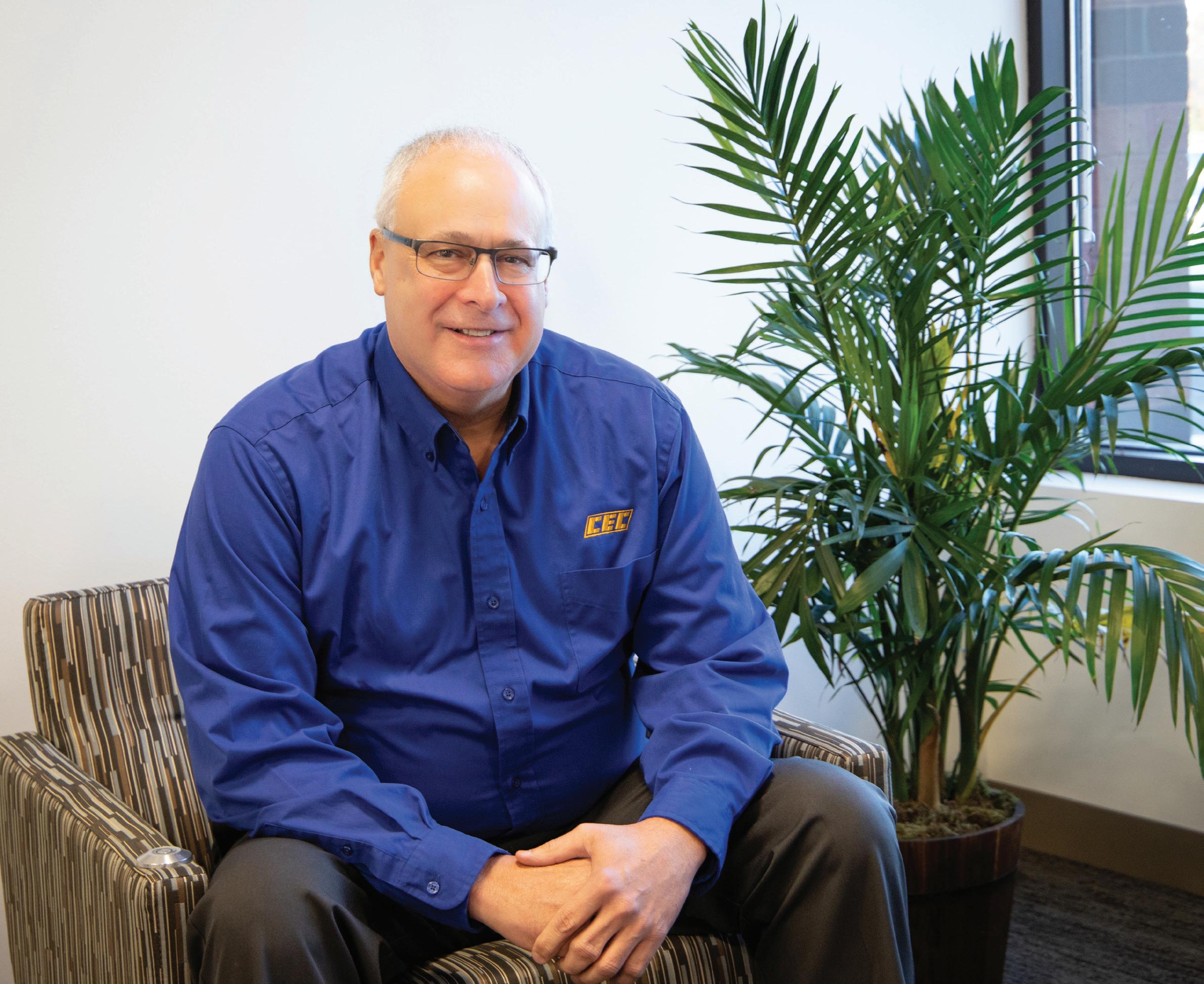
13
QUESTION:
WHAT HAVE BEEN THE BIGGEST CHANGES IN TRANSPORTATION OVER THE COURSE OF YOUR 30+ YEAR CAREER?
ANSWER: “Without a doubt, it’s the advancements in technology. Thirty-four years ago, there were two computers in the office. We had to make an appointment to use one. Five years later, AutoCAD had taken hold, so we staggered our work days so everyone was able to use the computers. Now we can’t do business without them. Technology is also changing things out on the road. Historically, the blinking changeable message roadside signs (warning of slowdowns or construction, etc.) are rendered useless once you pass, because you would not see any
updated information. With apps like Pennsylvania’s 511PA, drivers are alerted to traffic and road condition updates
continuously and in real time via smart phones, and in-car applications like Apple CarPlay and Android Auto.”
QUESTION: HOW ARE TECHNOLOGICAL ADVANCEMENTS GOING TO AFFECT THE ROADS OF THE FUTURE?


ANSWER: “I think some of the biggest changes we will see in the future will deal with electric cars. There have been advancements of the ‘vehicle electrification’ systems of roads. In other words, electric cars will be charged as they travel along certain portions of a highway. That brings more questions: ‘How fast can a vehicle travel and still be charged? How will drivers pay for the charge? What is the life expectancy of the road and
the charging system?’ Long-haul trucking companies are very interested in this concept, as it would save them both time and money. As technology changes, the associated jobs will also change. As a people, we are always adapting to change. If I were to venture a guess, the transportation industry will take the baton and keep moving ahead. And I plan on being part of that transformation for a very long time.” ■
ELEMENTS
14
In case you missed it ...
ICYMI
A look back at regulatory and government-related updates
We’re always monitoring the regulatory landscape so we can keep you up to speed on important changes and their effects.
Here is a collection of posts from our blog, in which we update you on some of the more pertinent topics from the regulatory world.
cecinc.com/blog
OHIO COMMUNITIES CAN LOOK FORWARD TO RENEWED FUNDING
NJDEP PROMULGATES
LANDMARK ENVIRONMENTAL JUSTICE REGULATION

USACE SPECIAL CONDITION REQUIRES NEW PNDIS
NEW TCEQ RULE PROPOSED ON REGULATING STORAGE VESSELS
CONNECTICUT SEVERE OZONE NONATTAINMENT RECLASSIFICATION

AMERICAN RESCUE PLAN ACT OF 2021 UPDATE

STORMWATER MANAGEMENT IN PA WILL SEE SIGNIFICANT CHANGES



On May 10, 2021, the U.S. Department of the Treasury announced the launch of the Coronavirus State and Local Fiscal Recovery Funds, established by the American Rescue Plan (ARP) Act of 2021. The ARP provided $350 billion in funding for eligible governments. The money must be spent by the end of 2024, so it’s vital for public entities to determine now how to allocate the funding.
CEC is helping a multitude of municipalities decide how to spend that allocated funding.
“We are guiding them to projects that qualify for funding,” Tim Murphy, CEC’s Corporate Public Sector Market Group Lead, says. “To date, we are mainly working with smaller communities who have limited experience receiving this level of federal funding. We are helping with everything from how to appropriately allocate the funds to assisting the communities with preparing the proper documentation that meets the necessary reporting requirements.”
One example is Franklin Park Borough, just north of Pittsburgh.

Justin Wagner, a Principal in CEC’s Pittsburgh office, is the stormwater engineer for the 13-square-mile municipality. He assists the borough with meeting its PAG 13 Municipal Separate Storm Sewer System (MS4) permit obligations, as well as other stormwater improvements in chronic flooding areas and some proactive infrastructure assessments.
Pennsylvania requires urbanized stormwater communities to implement and construct Best Management Practices (BMPs), which reduce the sediment and nutrient loadings through various types of projects. The BMPs are most often stream restoration, stormwater basin retrofits, infiltration basins, or other types of water quality BMPs that are most effective with sediment reductions.
Franklin Park received more than one million dollars in funding from ARP and has allocated it toward fulfillment of its MS4 obligations.
15
ELEMENTS

FREE webinars Register now at cecinc.com/etc ETC Fall Schedule Solar Development 101 Intro to NEPA Intro to Environmental Regulations Intro to Stream & Wetland Delineation 9/28 10/12 11/16 12/7 CEC Headquarters 700 Cherrington Parkway Moon Township, PA 15108 Senior Leadership Integrated Services Personal Business Relationships





 Dustin Kuhlman, President & CEO
Dustin Kuhlman, President & CEO


























